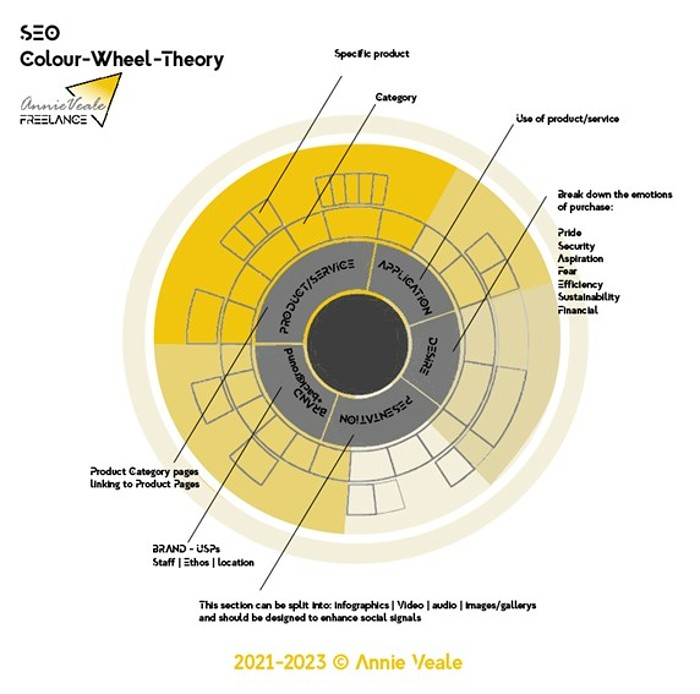Don't let SEO blow your mind! Even though the sheer nature of SEO requires both "big picture" thinking and granular hyper-accurate attention to detail...
That scale of research as well as attention to details is required to give your site an opportunity to perform and achieve reach, both on your competitive and often transactional search terms and when creating early customer lifecycle touchpoints.
The number of theories and guides relating to SEO is extensive, and to digest it all would most likely blow your mind—and, to implement, likely blow your budget!
It is also true that the more SEO you understand and the more of a specialist you become, the more the task of SEO becomes unwieldy—i.e., the mind maps that often exist to launch or create content groups can (and often need to be) the stuff of extensive research, gut feeling, technical expertise, and expert opinion.
However, color wheel theory is well worth a look; and, if nothing else, it should help you visualize your SEO and fine-tune it into a logical structure—which, after all, is one of the important keys to achieving SERPs success.
It should also serve as a valuable tool to communicate to internal teams, or those working on the project exactly what is going to be produced and what topics and keywords are being targeted within the overall, more complex, website structure.
What Content SEO Actually Involves
"Content SEO refers to creating content that helps your webpages to rank high in the search engines. It includes everything to do with the writing and structuring of content on your website." — Yoast
Essentially, in regard to the writing and formatting of content, SEO refers to topic identification, campaign-relevant content, posts and micro-topics, and the media files within topic pages.
Also, it refers to creating such content within an SEO framework—that is, the need to build out that content while observing and satisfying the rules for both on-page SEO and off-page SEO:
- On-page SEO includes things such as anchors, meta text, the actual written words, links, and the SERP features and media included in constructing and publishing the page/article.
- Off-page SEO is rarely entirely in the control of the writer or publisher, and it refers to backlinks, whether natural or organic, manual, or self-created. They all have the potential to increase the position of the page. Effectiveness depends on factors such as the popularity and trust scores of the referring domain, the topic relevance, and the number of links on the linking page.
What Is SEO Color Wheel Theory?
Color wheel theory allows a framework to be built that hinges on creating 5-6 groups for your website that are designed to tap into the psychology of the user doing the search.
From there you create your categories of content and further identify "micro-topic" links and anchors. Those micro-topics, in turn, also provide additional linking or sharing opportunities to your site's key pages and key social accounts.
Ultimately, the center of the wheel will indicate indexed pages that will most likely attract new visitors.
On the whole, it is your indexed core site pages and landing pages that sit on the outer layers of the wheel. And each segment, from outer to inner, serves to improve the effectiveness of the content within that content group and topic. A well-known methodology coined by HubSpot, the Topic Cluster, has a similar structure.

How to Complete Your SEO Color Wheel
The color wheel requires some degree of knowledge of SEO to be fully implemented.
I would suggest this model for those of mid-weight expertise, or those involved in project management of SEO and content marketing specialists.
Focus on one segment at a time, working around to complete the wheel. The media segment is to house your most visually shareable content, such as PR articles, videos, graphics, and images.
First, identify 5-6 categories that form the inner circle of content and psychology:
- Brand and background
- Product and service pages
- Application of product or service (use cases, case studies, in action, etc.)
- Purchasing motives
- Media section (audio, video, imagery, PR)
Then, follow these steps:
- Make a list of your core pages and landing pages—those you are most interested in people landing on and that are most pertinent to your business activities and offers.
- Go around the outside of the wheel and place those pages in a box on the outer segment of the wheel. Each category should have at least three pages per outer section.
- Make a list of your top performing micro-topics—those that receive the most organic traffic and are breakout topics. For example, it may be a page with specialist knowledge on a product or a generic page about a local event you and your team attended. Place those pages in the appropriate topic segment on the innermost section of the wheel (the gray section in the diagram).
At this point, you should have a clear indication of the categories that you are lighter on or those that you have excess content for.
The pages you have listed and yet not been able to place in either the outer or inner segments are key pages for improving traffic to both the inner micro topics and outer; they are volume landing pages. They should sit in the middle segment, adjoining and linking inner to outer pages. You may well find that that section of your site does not exist at all, and that your list has already been placed within the inner or outer circle.
You have now identified content areas where to build out and improve your SEO.
Possible Scenarios After Completing Your Color Wheel—And What to Do
1. You have a huge number of pages listed that are not in the diagram
This would indicate that you may have to look at introducing new categories to your site or, worst case, that you have content cannibalization issues.
You will need to do a thorough audit to figure out the best course of action, but you should identify content that needs to be created that links the inner and outer page topics and pre-existing pages that that need work.
Why do this?
Those pages will produce the most powerful internal links; and, in turn, if you link to the most important outer page from multiple specialist or micro-topics, the individual keywords for each page will be bolstered. As a result, your site will have an increased chance of SERP features and sitelinks on the outer/landing pages.
2. There are huge gaps in the color wheel and no site pages with which to complete the segments
This would indicate that your site is too thin. You need to look at creating additional content and pages within each category for a website structure that replicates the wheel's inner (gray) categories. You will need to do competitor and keyword analysis to find out what content areas to build out.
Why do this?
Your site completeness, and likely the logic and depth required for you to rank, is not sufficient. You will likely have sporadic or even broken positions in your search performance; and although you may have good keywords and pages indexed, they will likely be for keyword difficulty of around 40 or higher.
3. You have a fairly complete color wheel
Excellent news: you have been doing a good job on your content!
The next step is to identify what your main objectives are. Are you trying to increase position or gain SERP features? Perhaps you have an inclination that your pages are not attracting the right users, and you are suffering from low onsite engagement levels as a consequence?
The SEO color wheel clearly visualizes the main topic and content areas. Now you are ready for the next level in SEO: focusing on internal links, outreach and backlinks, schema, and building out SERP features.
Who Is the SEO Color Wheel Theory Suitable For?
This framework has three areas of prime use:
- A visualization tool for content SEO projects
- A planning tool for content SEO projects
- A framework with which to ensure your site structure remains logical, to identify cannibalization or thin topic areas
The framework is ideal for business owners, agencies, and in-house marketing teams wanting or needing a visual tool to plan and execute a content strategy for the purposes of website SEO. It is a particularly useful framework for large sites, or sites that have an unwieldy structure and need to tighten up content, or sites that suffer from page cannibalization.
Give it a try!
More Resources on SEO and Website Content Frameworks
Tips for Onsite Content Optimization With a Human Touch
Three Actionable SEO Techniques to Improve Your Website Right Now
How to Optimize Page Titles to Strengthen Your Website's SEO




